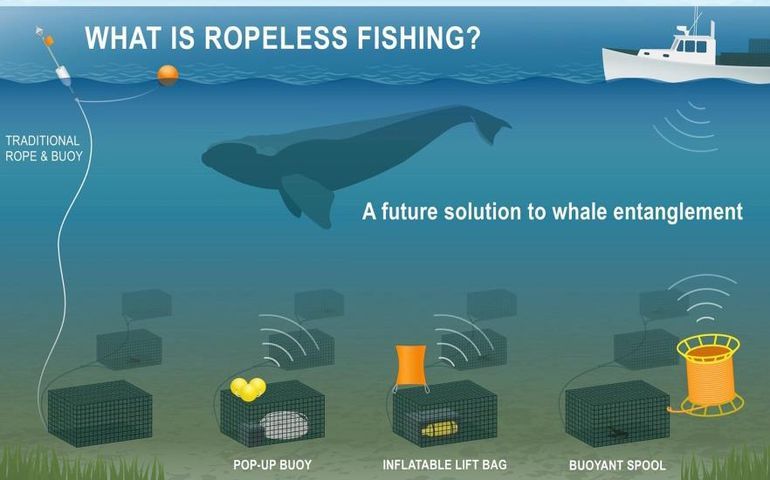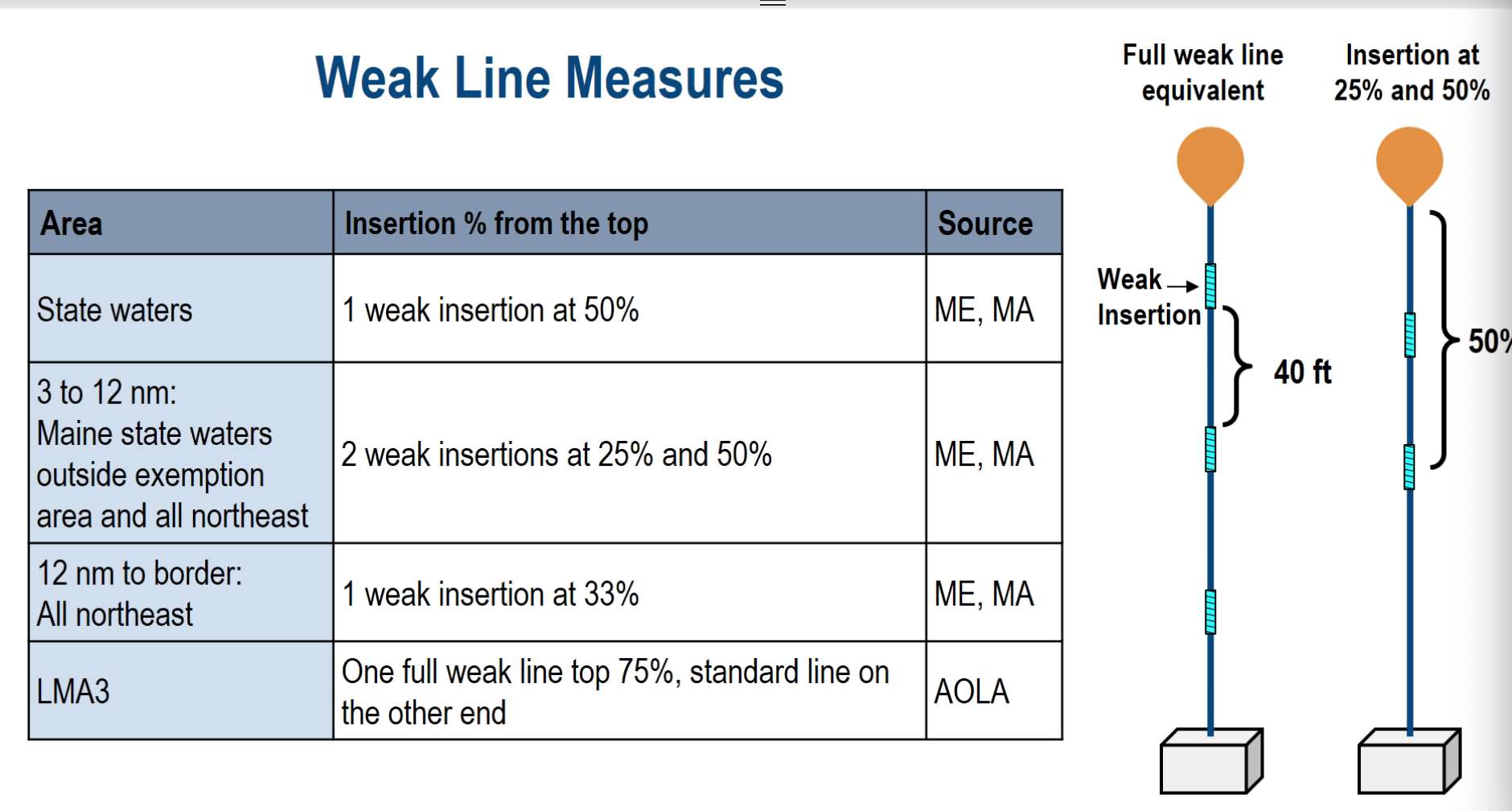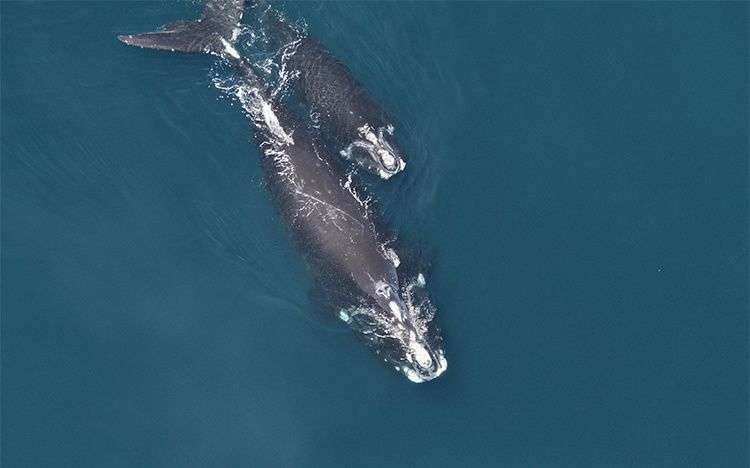
Extinction worries loom for both lobster industry and right whales
 COURTESY / NORTHEAST FISHERIES SCIENCE CENTER
This image shows three types of ropeless fishing on the right, compared with the use of a traditional rope connected to a surface buoy, on the left.
COURTESY / NORTHEAST FISHERIES SCIENCE CENTER
This image shows three types of ropeless fishing on the right, compared with the use of a traditional rope connected to a surface buoy, on the left.
Lobster fishermen are worried that federal regulations, proposed to protect the endangered North Atlantic right whale from entanglement in fishing gear, could put the industry out of business.
Conservationists worry the whale won’t survive much longer, given increased concerns about gear entanglement and ship strikes.
The National Marine Fisheries Service — an agency that’s part of the National Oceanic and Atmospheric Administration and is responsible for overseeing fishing in federal waters — is in the midst of holding hearings on proposed modifications to the federal government’s “Atlantic Large Whale Take Reduction Plan.”
Proposed changes aim to reduce entanglement in trap and pot fisheries for right whales, as well as humpback and finback whales, in order to reduce death and serious injury in accordance with two federal fishery laws, the Marine Mammal Protection Act and the Endangered Species Act.
Lobstermen like Kennebunkport-based Eben Nieuwkerk cited the high cost getting outfitted with the needed gear, especially for small-boat fishermen.
“It’s absolutely unacceptable,” Nieuwkerk said at a hearing Tuesday.
“If we remove all of the endlines, the right whale population will still plummet. So why are we taking these efforts if they won’t help?” said Harpswell fisherman Matt Gilley.
“Our entire life savings are tied up in the industry,” said Friendship fisherman Dustin Delano.
Proposed modifications would:
• Reduce the number of vertical lines, also called endlines or buoy lines, that connect traps on the sea floor to buoys on the water’s surface. The proposal is to require more traps between buoy lines.
• Introduce so-called “weak” insertions or rope into buoy lines that would make it easier for whales to break free if they do become entangled.
• Modify existing seasonal restricted areas to be closed to buoy lines.
• Add up to two new seasonal buoy line closures.
• Modify gear marking to introduce state-specific marking colors and increase the number of and area of marked lines.
• Introduce the possibility of fishing with “ropeless” gear, a type of technology that’s still in development.

According to the National Marine Fisheries Service, the changes will affect about 2,500 lobster vessels that would have to make changes to the way they fish.
The material and labor costs caused by the proposed rule in the first year are estimated to be $7 million to $15.4 million.
Maine is home to the nation’s largest lobster fishery.
Environmentalists said they support the proposals and advocated for taking them further.
“One or two weak insertions won’t reduce risk of entanglement,” said Bill McWeeny, a Brooksville resident and member of a group called Mainers Guarding Right Whales.
Gib Brogan, a fisheries campaign manager at an international advocacy group called Oceana, said the proposed rule is inadequate. Weak insertions, he said, provide little protection for juveniles and calves that can’t break out. The time and area management approach needs to be expanded to respond to unexpected aggregations of right whales, he added.
“The agency needs to strengthen the conservation measures to provide a clear path of protection to right whales from this known risk,” Brogan said of the lobster fishery.
98% risk reduction
The service specifies a 98% risk reduction over 10 years.

“To say this reduction will be devastating to the viability of Maine’s fixed gear fisheries is an understatement,” said Department of Marine Resources Commissioner Patrick Keliher in a letter to the service.
Keliher said that, even when the risk in the federal fishery is reduced to zero, the right whale population continues to be affected by Canadian fisheries and vessel strikes.
He said an analysis upon which the proposal is based, called a “biological opinion” and required by the federal Endangered Species Act, has flawed assumptions.
“The first assumption is that, for entanglements where the country of origin is unknown, 50% are attributed to Canadian fisheries and 50% are attributed to U.S. fisheries,” he wrote.
The department contends the 50/50 split is not supported by the data, he said: Of what is known in the entanglement record, 18 were confirmed to Canadian fisheries and eight were confirmed to U.S. fisheries. Canadian entanglements appear to be more deadly, he added, with nine of the 18 Canadian entanglements resulting in death or injury, while only two of the U.S. entanglements did.
Additionally, the analysis assumes all vertical lines have an equal risk of entanglement, he said: Most of Maine’s lobster fishing occurs in areas with little risk to right whales, he wrote.
The only way for Maine’s lobster fishery to achieve a 98% risk reduction in federal waters “is to completely reinvent the fishery and convert to largely ropeless fishing,” Keliher wrote. “At present, this is an untenable solution. The technology is still under development and many important questions remain regarding how ropeless fishing will work within the broader marine environment.”
Ropeless fishing refers to technology used to haul lobster traps from the ocean’s bottom by using an acoustic signal rather than by a length of rope.
The transition to ropeless gear also comes at a high social and economic cost to the fishing industry, he added. Ropeless technology costs are significantly higher than those of existing operations, with an individual acoustic-release unit estimated to cost $3,750. For a lobsterman fishing a full allocation of traps in eight-trap trawls, that could amount to nearly $375,000, he said.
“Multiplied by the approximately 1,350 federal lobster permit holders in Maine, the cost could easily exceed half a billion dollars for conversion of the entire fleet,” Keliher continued.
Long-term costs
There will be additional long-term costs, he said, in terms of loss of business to marine service and supply industries, the need to retrofit or replace vessels to ensure sufficient deck space, and costs associated with gear loss.
“Of any jurisdiction, Maine will be the hardest hit by these economic impacts given 82% of U.S. lobster is landed in Maine, with ex-vessel revenues of approximately $500 million annually and an additional $1 billion in indirect economic impact to the state,” Keliher said. “In many rural coastal communities, there are limited career alternatives, making the fishing industry, and more specifically the lobster fishery, the backbone of Maine’s coastal economy.”
In a letter to the service, Gov. Janet Mills expressed “grave concern” about the plan, calling it “economically devastating” and saying it would fundamentally change Maine’s lobster fishery.
Mills said the Maine lobster industry has worked for decades to protect right whales.

“Maine fishermen have worked collaboratively with the Department of Marine Resources for over 20 years to develop and implement measures to protect whales,” she wrote. “They have been active participants at the Atlantic Large Whale Take Reduction Team table, looking for solutions that both maximize benefits to right whales and remain practicable for safe operations at sea.”
Mills said the 98% risk reduction target will result in an inevitable conversion to ropeless fishing.
“If this comes to pass, it is not only fishermen and their crew who will be impacted, gear suppliers, trap builders, rope manufacturers – all these businesses face a deeply uncertain future,” she wrote.
Nieuwkerk said the cost of converting to ropeless gear will price small boats and young fishermen out of the business.
Said Delano: “If our government is going to destroy us, we’re at least owed a way out if we can’t survive.”
According to the latest federal data, the North Atlantic right whale is one of the most endangered large whale species, with under 400 whales, and fewer than 100 breeding females remaining in the world. Since 2017, about 10% of the population – 32 whales – has either died or been seriously injured.
The comment period on the proposed rule closes March 1. The final rule is expected to publish this summer, with delayed effective dates for gear changes likely.
For more information on the proposed rule, click here.










0 Comments